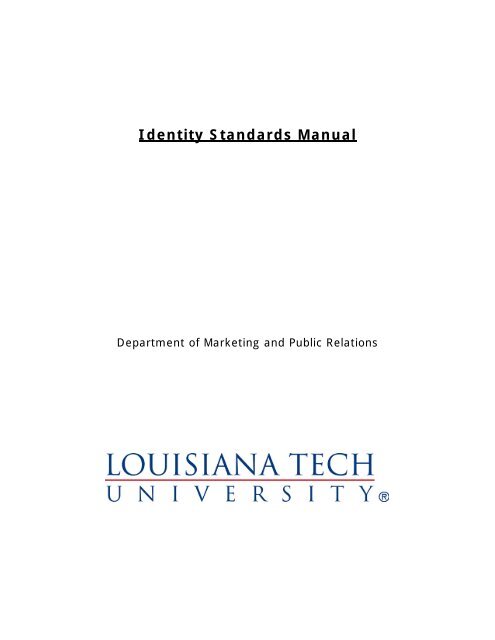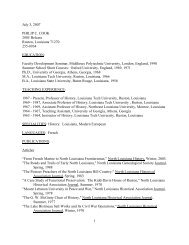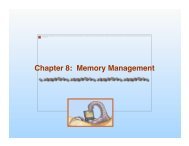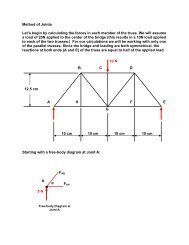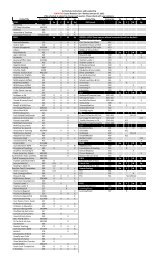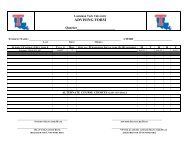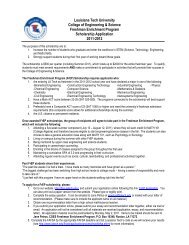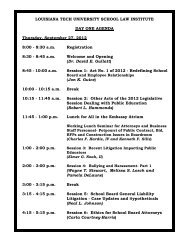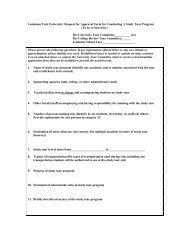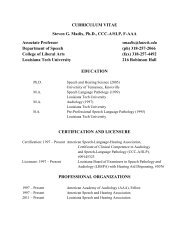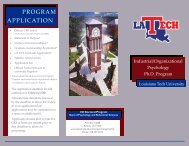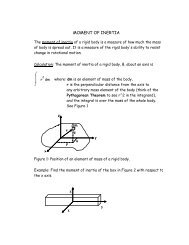Identity Standards Manual - Community
Identity Standards Manual - Community
Identity Standards Manual - Community
Create successful ePaper yourself
Turn your PDF publications into a flip-book with our unique Google optimized e-Paper software.
<strong>Identity</strong> <strong>Standards</strong> <strong>Manual</strong><br />
Department of Marketing and Public Relations
Table of Contents<br />
President’s Letter……………………………………………………………. 3<br />
Introduction……………………………………………………………………… 4<br />
<strong>Standards</strong> and Quality Oversight……………………………………. 5<br />
A Brief Discussion on Copyright Law………………………………. 6<br />
Official Colors…………………………………………………………………… 8<br />
University Logos and Word Marks………………………………….. 8<br />
Athletics Logos and Word Marks…………………………………….. 11<br />
Samples of Unacceptable Logos…………………………………….. 12<br />
University Seal…………………………………………………………………. 13<br />
Reference to University Name………………………………………… 13<br />
Letterhead and Business Cards………………………………………. 14<br />
Writing Style Guide…………………………………………………………. 17<br />
2
One way to achieve broader awareness and comprehension of<br />
Louisiana Tech University, and to help distinguish Tech, is through<br />
consistent use of a distinct visual identity. The appearance of our<br />
publications, our correspondence, our signs, and the visual marks that<br />
we use all help shape attitudes about Louisiana Tech.<br />
The <strong>Identity</strong> <strong>Standards</strong> <strong>Manual</strong> has been created to assist our<br />
constituents in communicating this consistent message and visual<br />
presentation of the University. This effort helps to ensure that the<br />
message being presented through our logos, word marks, and other<br />
graphical images is one of organizational strength and excellence.<br />
I ask everyone who develops or uses materials that represent<br />
Louisiana Tech to cooperate in this effort to establish and maintain a<br />
consistent visual image for our University. The Department of<br />
Marketing and Public Relations is available to assist you in this area<br />
and to answer any questions you might have regarding the <strong>Identity</strong><br />
<strong>Standards</strong> <strong>Manual</strong>.<br />
Sincerely,<br />
Daniel D. Reneau<br />
President<br />
3
Introduction<br />
The visual presentation that Louisiana Tech University communicates<br />
to its stakeholders has been developed and refined over many years to<br />
ensure that the impact of its message is clear and consistent. The<br />
Marketing and Public Relations Department is responsible for working<br />
with the executive officers to maintain the integrity of the University’s<br />
visual identity and to ensure that the message it conveys through its<br />
visual marks is one of organizational strength and academic<br />
excellence.<br />
The purpose of the <strong>Identity</strong> <strong>Standards</strong> <strong>Manual</strong> is to assist both internal<br />
and external organizations in recognizing the official Louisiana Tech<br />
logos and word marks that uphold our graphical standards and<br />
advance the University’s branding and imaging strategy. These visual<br />
marks are used to communicate instantly to any audience that we are<br />
Louisiana Tech University in a way that cannot be equaled by other<br />
complex or abstract designs. Therefore, it is essential that the use<br />
of Louisiana Tech logos and word marks in ALL applications be<br />
consistent and accurate.<br />
4
<strong>Standards</strong> and Quality Oversight<br />
The Marketing and Public Relations Department is responsible for<br />
preserving the University’s identity standards and assisting internal<br />
and external entities requesting the use of all Louisiana Tech logos and<br />
word marks. It is tasked with providing guidelines for usage and the<br />
official logo and/or word mark files should the request adhere to<br />
accepted University standards. For additional usage guidelines and to<br />
request official logo/word mark files, please contact Marketing and<br />
Public Relations at:<br />
Louisiana Tech University<br />
Marketing and Public Relations<br />
PO Box 3172<br />
Ruston, LA 71272<br />
(318) 257-4854 – phone<br />
(318) 257-4938 – fax<br />
eparker@latech.edu<br />
The name, marks and images of Louisiana Tech University cannot be<br />
used to suggest or imply endorsement of any commercial product or<br />
service not directly affiliated with Louisiana Tech or approved by the<br />
University’s executive officers. The marks are also not to be used to<br />
endorse or promote alcohol, drug or tobacco related products. The use<br />
of any Louisiana Tech logos or word marks for promotional or<br />
charitable purposes must be approved by the Marketing and Public<br />
Relations Department in accordance with University standards.<br />
Louisiana Tech logos, word marks or graphical images must never be<br />
altered or incorporated into other logos.<br />
Louisiana Tech identity marks are licensed through Collegiate Licensing<br />
Company (CLC). Reproduction of any Louisiana Tech logos, seals<br />
and/or word marks must be done through officially licensed vendors<br />
only. For information about fee assessments and a list of officially<br />
licensed vendors, contact the Marketing and Public Relations<br />
Department at (318) 257-4854 or Collegiate Licensing Company at<br />
(770) 956-0520.<br />
The information contained in this manual attempts to identify as many<br />
scenarios as possible as they pertain to accepted and unaccepted<br />
usage of Louisiana Tech University identity marks. Examples that are<br />
5
not cited in this manual will be reviewed on a case-by-case basis and<br />
will be considered using the same standards. Louisiana Tech<br />
University reserves the right to restrict the use of these logos and/or<br />
word marks should it deem them detrimental to the University.<br />
A Brief Discussion of Copyright Law<br />
The following information is adapted from the Library of<br />
Congress/United States Copyright Office’s homepage. Those looking<br />
for a more detailed explanation on copyright should consult the U.S.<br />
Copyright Office or, for legal advice, an attorney.<br />
What is copyright law<br />
Copyright is a form of protection provided by the laws of the United<br />
States under Title 17 of the U.S. Code. The protection extends to<br />
authors of “original works of authorship,” including literary, dramatic,<br />
musical, artistic, and certain other intellectual works. This protection is<br />
available to both published and unpublished works. It is illegal for<br />
anyone to violate any of the rights provided by the copyright law to<br />
the owner of copyright. Copyright protects “original works of<br />
authorship” that are fixed in a tangible form of expression.<br />
Copyrightable works include the following categories:<br />
• literary works<br />
• musical works, including any accompanying words<br />
• dramatic works, including any accompanying music<br />
• pantomimes and choreographic works<br />
• pictorial, graphic, and sculptural works<br />
• motion pictures and other audiovisual works<br />
• sound recordings<br />
• architectural works<br />
These categories should be viewed broadly. For example, computer<br />
programs and most “compilations” may be registered as “literary<br />
works”; maps and architectural plans may be registered as “pictorial,<br />
graphic, and sculptural works.” A work that is created on or after<br />
January 1, 1978, is automatically protected from the moment of its<br />
creation and is ordinarily given a term enduring for the author’s life<br />
plus an additional 70 years after the author’s death (or, in the case of<br />
multiple authors, 70 years after the last surviving author’s death).<br />
Copyright is secured automatically when the work is created. The work<br />
is considered created when it is fixed in a copy or phonorecord for the<br />
6
first time. Copies are material objects from which a work can be read<br />
or visually perceived either directly or with the aid of a machine or<br />
device, such as books, manuscripts, sheet music, film, videotape, or<br />
microfilm.<br />
What is a trademark<br />
A trademark is a word, phrase, symbol, design, combination of letters<br />
or numbers, or other device that identifies and distinguishes products<br />
and services in the marketplace. A trademark is denoted by the<br />
trademark symbol, which is , or alternatively by the federal<br />
registration symbol, which is ®, if an actual registration filing has been<br />
approved by the United States Patent and Trademark Office (USPTO).<br />
A service mark offers virtually the same protection as a trademark, but<br />
is used instead to identify and distinguish services, rather than<br />
products. When the term “trademark” or “mark” is used, it is<br />
understood to include service mark as well. Trademarks are usually<br />
synonymous with the brand name or design that is applied to a<br />
business or its products or used in connection with services.<br />
Whereas patents and copyrights are basically used to protect the<br />
commercial rights of inventors and creators of artistic or literary<br />
works, respectively, the basic concept behind a trademark or service<br />
mark is to prevent unfair competition.<br />
Trademark law provides protection from other organizations using the<br />
trademarked identity or using a name or symbol so similar that it<br />
could cause confusion to clients or customers. By identifying a product<br />
or service’s source, a mark also serves to protect consumers from<br />
deception.<br />
The difference between copyright and trademark<br />
The purpose of a copyright is to protect works of authorship as fixed in<br />
a tangible form of expression (see examples in previous section). A<br />
copyright protects a form of expression, but not the subject matter of<br />
the work.<br />
The purpose of a trademark is to protect words, phrases and logos<br />
used in federally regulated commerce to identify the source of goods<br />
and/or services. A trademark may also be used to prevent others from<br />
using a mark that might be confused with another.<br />
7
Official University Colors<br />
Color<br />
Sample<br />
Color Name HEX Code RGB Code CMYK Code<br />
Tech Red (official) –<br />
PMS 1797<br />
#E31B23 227,27,35 0,100,99,5<br />
Tech Blue (Reflex -<br />
official) – PMS 287<br />
#002F8B 0,47,139 100,70,0,5<br />
Hex and RGB codes are used for Web production and PowerPoint presentations. Use PMS spot color and<br />
CMYK codes for printing collateral material (posters, brochures, flyers, and such) and promotional<br />
specialty items. Due to newer printing methods, use these codes for a more accurate color match.<br />
In order to provide graphic consistency, Tech’s official red and blue<br />
should conform to official colors designated by printer’s ink color<br />
designations as listed above. The Marketing and Public Relations<br />
Department is available to assist with samples and codes for these and<br />
other color options.<br />
University Logos and Word Marks<br />
Louisiana Tech University’s logos and word marks are the primary<br />
visual identifiers for the University and can be used in all printed and<br />
electronic communications pieces. These visual marks are the property<br />
of Louisiana Tech University and must be used in accordance with the<br />
University’s identity standards. To maintain visual integrity, Tech’s<br />
logos and word marks should appear consistently in application and<br />
never be used in an unorthodox manner that might compromise the<br />
basic configuration. Private vendors wishing to use these visual marks<br />
on commercial merchandise must contact Collegiate Licensing<br />
Company for rights and terms of use.<br />
Logo and work mark files are easily downloadable from the<br />
Department of Marketing and Public Relations webpage.<br />
• Go to http://www.latech.edu/mpr/tech-logos.shtml.<br />
• Enter first and last name, organization, email address and<br />
reason for the request.<br />
• Check the boxes for the logo and/or word mark files you need.<br />
• After submitting the request, the items will be instantly sent to<br />
the email address you listed on the form.<br />
8
Versions of the logos or word marks not specifically shown in the<br />
examples below must be approved by the Department of Marketing<br />
and Public Relations prior to being used.<br />
Samples of Approved State-and-T Logo<br />
College-specific State-&-T logo<br />
Samples of Approved Word Mark<br />
Two-Color<br />
One-Color<br />
9
Samples of Approved Logo with Word Mark<br />
State-&-T Word Mark<br />
The T-and-state logo, used alone or with the word mark is the primary,<br />
trademarked graphic standard for Louisiana Tech University. Unless<br />
specifically approved, when used in its two-color version, the state must be<br />
blue and the "T" must be red. A protected area of white space, as illustrated,<br />
is necessary around the T-and-state and/or word mark to obtain the<br />
symbols' integrity and visual impact. It should also be noted that there is<br />
always a small space between the state and the “T” and at no time do they<br />
touch.<br />
The State-and-T logo can be used as a stand-alone mark in local or regional<br />
publications and presentations. For national and international purposes,<br />
however, the word mark will need to accompany the State-and T logo so as<br />
to identify the mark as being representative of Louisiana Tech University.<br />
Minimum sizes have been established to ensure that the symbols can be<br />
reproduced adequately. The minimum width of the word mark by itself is 1¼<br />
inches. The minimum diameter of the T-and-state depends on the medium<br />
and its usage. The minimum width of the word mark with the T-and-state is<br />
2 ½ inches (with the exception of business cards).<br />
10
Athletics Logos and Work Marks<br />
In addition to the traditional institutional marks, Louisiana Tech’s Athletics<br />
Department also uses specially-designed logos and word marks in many of<br />
their administrative and promotional materials.<br />
With the exception of the Bulldog logo, the following marks are used for the<br />
identification, promotion and/or advancement of the Louisiana Tech Athletics<br />
Department and its teams ONLY. They are not to be used to brand or<br />
identify the University’s academic or administrative departments, unless<br />
specifically approved by Marketing and Public Relations. Use of these<br />
athletics marks must also be done in accordance with the guidelines and<br />
standards set forth in this manual.<br />
“LA Tech” State-&-T Logo (Athletics)<br />
Bulldog Logo<br />
Lady Techsters Word Mark<br />
Lady Techsters Word Mark (Horizontal)<br />
IMPORTANT - The term LA Tech is only permitted when referring to athletics. It<br />
may not be used when referring to academics. LA Tech can only be used in<br />
font and word mark shown above. No other interpretation or font is acceptable.<br />
11
Samples of Unacceptable Logos<br />
Vertically Stretched Horizontally Stretched Incorrect State-&-T “T” placed directly on state<br />
Blue “T” - Red State Tech logo as part of another logo Changing verbiage of word mark<br />
Improper use of colors in logo<br />
Outlining of “T” and/or State-&-T<br />
Old Academic logo usage Academic usage of Athletic Logo Improper use of colors in logo<br />
12
University Seal<br />
The University's presidential seal (used as a silver or gold foil stamp) should<br />
be reserved for executive materials for the University’s President and Vice-<br />
Presidents. Please note that the university seal and the T-and-state logo are<br />
not to be used together.<br />
The minimum diameter for the seal is ¾ inch. When the seal and word mark<br />
are used together, the size of the seal in relation to the word mark should<br />
appear as shown above.<br />
Reference to University Name<br />
References made to Louisiana Tech University, by name, in promotional<br />
materials should be used according to the guidelines in the following section.<br />
Accepted Usage:<br />
Louisiana Tech University<br />
Louisiana Tech<br />
Tech<br />
Bulldogs<br />
Lady Techsters<br />
LA Tech (athletics only)<br />
Unacceptable Usage:<br />
La (LA) Tech University<br />
La Tech (using lowercase ‘a’)<br />
Tech University<br />
Louisiana Polytechnic Institute<br />
Louisiana Technical University<br />
Louisiana Technical College<br />
Louisiana Technical<br />
La (LA) Technical<br />
LT University<br />
LTU<br />
Techsters (w/o Lady)<br />
Lady Bulldogs<br />
13
Letterhead and Business Cards<br />
University stationery sends a powerful visual message about the writer and<br />
the institution. A consistent visual image provided by the T-and-state logo is<br />
needed to project institutional unity. An example of stationery using the<br />
word mark and logo is shown below. The Marketing Team will assist you in<br />
preparing stationery. The stationery may be printed in black or blue ink (one<br />
color) for an inexpensive product. The standard, acceptable two-color<br />
product is shown here.<br />
14
University envelopes in various sizes are printed with the word mark in a<br />
one- or two-color standard. (A one-color envelope is set in blue or black).<br />
Other information in the envelope return address should be pattered after<br />
the companion stationery.<br />
Business cards often introduce Tech to people who are not familiar with us.<br />
It is important that this visual contact convey an identity that can be<br />
reinforced in subsequent contacts through consistent use. On Tech business<br />
cards, the T-and-state logo and word mark must be used as a unit. Business<br />
cards can be set horizontally or vertically.<br />
Louisiana Tech has a blanket bid to cover business card ordering needs. Our<br />
vendor uses an online ordering system that allows Tech faculty and staff to<br />
order business cards through a Web-based template. The secure online<br />
ordering process requires a user ID and password which can be obtained by<br />
contacting the Department of Marketing and Public Relations at 257-4854. It<br />
also requires payment with a Louisiana “La Carte” Purchasing Card or a<br />
personal credit card.<br />
15
To start the electronic ordering process:<br />
• Contact Department of Marketing and Public Relations for user ID and<br />
password.<br />
• Go to http://www.latech.edu/faculty-staff/<br />
• Click on the “Order Business Cards” link. You will find detailed<br />
instructions for ordering, as well as frequently asked questions.<br />
• Fill in required information to place your order (or group of orders).<br />
Contact the Marketing and Public Relations department at if you have<br />
questions not answered by the Web instructions.<br />
When given the opportunity to view your proof during the online<br />
ordering process, be sure to print out your order confirmation so you<br />
can attach it to your purchasing card statement at a later date.<br />
16
Writing Style Guide<br />
ON FORMS<br />
For consistency and identity, external university forms must include the T-<br />
and-state logo with the wordmark or the T-and-state by itself.<br />
ON PUBLICATIONS<br />
The wordmark and T-and-state logo must appear prominently on all<br />
university publications, although not necessarily as the predominant design<br />
element. The wordmark and the T-and-state logo may be used as additional<br />
graphic elements in publication.<br />
ON WRITING STYLE<br />
Consistency of writing style is as important to Tech's identity as consistency<br />
of design. This section is not a comprehensive text but is designed to<br />
address some of the diversity of writing style at Tech.<br />
The Marketing and Public Relations team uses and recommends The<br />
Associated Press Stylebook. There are always some exceptions to the rules;<br />
such exceptions are included in this guide as recommended style for use at<br />
Tech.<br />
ABBREVIATION<br />
Use abbreviations sparingly in correspondence or in text material; in all<br />
cases, spell out any word when meaning may be obscured by abbreviation.<br />
In first reference, spell out the name of an organization that may be<br />
abbreviated in subsequent references. Also in first reference, identify in<br />
parentheses the abbreviation to be used later: Louisiana Tech Concert<br />
Association (LTCA), Student Government Association (SGA), Bulldog Online<br />
Student System (BOSS).<br />
The initials "LTU" or "LA TECH" should not be used in publications. Instead,<br />
use "Louisiana Tech University" on first reference and "Louisiana Tech" on<br />
second reference. “Louisiana Tech” or "Tech" are appropriate in subsequent<br />
references.<br />
ACADEMIC DEGREES<br />
Spell out when possible: bachelor's degree, master's degree, doctorate or<br />
doctoral degree. Abbreviate specific degrees with periods and without spaces<br />
between the letters and periods: B.A.; M.S.; Ph.D.; M.B.A.; J.D.; M.D. Set<br />
off an abbreviated degree with commas after a full name: Mary Jones, Ph.D.,<br />
spoke. Refer to a person with a doctoral degree as Dr. on first reference<br />
17
only: Dr. Jane Smith spoke (first reference). Smith spoke (other references).<br />
ADDRESS<br />
In the inside address of a letter, spell out such words as street, road, or<br />
drive, as well as North, East, South, or West. Also spell out the names of<br />
states. Note that Tech post office boxes are unique to Ruston, therefore the<br />
use of "Tech Station" or "T.S." is unnecessary.<br />
Address Example:<br />
Louisiana Tech University<br />
P.O. Box 3178<br />
Ruston, Louisiana 71272-0001<br />
AGES<br />
Always use numerical figures.<br />
ALUMNAE/I<br />
Use alumna when referring to one female graduate and (alumnae in the<br />
plural), and alumnus for one male graduate (alumni in the plural). Use<br />
alumni when referring to a group of men and women.<br />
AMONG/BETWEEN<br />
Among implies a relationship between more than two objects: Louisiana<br />
Tech University awarded degrees to graduates of the College of Engineering<br />
and Science. Between implies a relationship between two objects: The<br />
College of Business divided the scholarship between John Smith and Jane<br />
Adams.<br />
AMPERSAND / AND<br />
Use the ampersand (&) for "and" only as part of an official corporate name:<br />
Deloitte & Touche.<br />
ANNUAL<br />
Do not use the term "first annual." An event cannot be described as annual<br />
until it has been held in at least two successive years.<br />
APOSTROPHE<br />
Omit an apostrophe when referring to a decade as a single period of time.<br />
Omit an apostrophe if the decase is abbreviated. John attended college in<br />
the 50s. He taught in the 1920s.<br />
CAPITALIZATION<br />
Use uppercase for the proper names of Tech's academic colleges, schools,<br />
departments and offices. Use uppercase to specify programs: Tech's<br />
18
Professional Aviation program. Use lowercase when non-specific: the<br />
aviation program. Use lowercase for seasons of the year, except when<br />
referring to Tech's academic quarters: The program was held in the spring.<br />
The Fall Quarter begins in September. Use lowercase for first-year students<br />
(or freshmen), sophomores, juniors or seniors when referring to individuals.<br />
But capitalize names of organized entities: Class of 1920, the Senior Class.<br />
Use lowercase for majors and degrees, including graduate degrees: She is<br />
earning a master's degree in physics. She is a biomedical engineering major.<br />
Capitalize specific course titles only; do not use quotation marks: History of<br />
European Political Theory; a course in psychology. Capitalize University<br />
when referring directly to Louisiana Tech University: The University was<br />
awarded $12 million by the state legislature to establish a research park.<br />
COMPOSITION TITLES<br />
Italicize the names of books, newspapers, journals, films, full-length plays,<br />
symphonies, operas, ships and airplanes. Use quotation marks around<br />
articles, poems, songs, one-act plays, television programs and sculptures.<br />
COMPUTER TERMS<br />
CD-ROM, database, download, E-mail or e-mail, home page, Web site, the<br />
Internet, online (no dash), World Wide Web or Web, not WWW.<br />
CONTINUAL/CONTINUOUS<br />
Continual means a steady repetition: The merger has been the source of<br />
continual litigation. Continuous means uninterrupted, steady, unbroken: All<br />
she saw ahead was a continuous stretch of road to Shreveport.<br />
DATES<br />
For days of the month, omit "rd," "th," "st," "nd."<br />
The event is scheduled for August 6.<br />
EMERITAE/I<br />
Use emerita when referring to one female retired professor or trustee, and<br />
emeritus for one male retired professor or trustee. Use the plural forms:<br />
emeriti when referring to males; emeritae (pronounced E-meri-tee) when<br />
referring to females; and emeritae/i when referring to males and females.<br />
HYPHENS<br />
Hyphenate part time and full time only when used as adjectives: He is a<br />
part-time instructor in the English department. She works full time in the<br />
music department.<br />
Don’t hyphenate vice president (or any other compound titles) in any<br />
reference.<br />
19
LOUISIANA TECH UNIVERSITY<br />
In first reference always: Louisiana Tech University. Second reference:<br />
Louisiana Tech. Subsequent references: Louisiana Tech or Tech. (see<br />
abbreviations)<br />
MORE THAN/OVER<br />
When referring to something that can be counted, use more than rather than<br />
over. The word over generally refers to spatial relationships: More than 50<br />
attended. The plane flew over Ruston.<br />
NUMBERS/NUMERALS<br />
Spell out one to nine; use numerals for 10 and above. Use numerals even<br />
for numbers below 10, when indicating: age, course credit hours, statistics,<br />
ratios, percentages and amounts of money. Use a comma after digits that<br />
signify thousands except when referring to temperature, year or SAT score:<br />
Tech enrolls more than 11,000 students.<br />
PERCENT<br />
Spell out percent in text, and always use numerals: Our retention rate is 85<br />
percent.<br />
PREFERRED SPELLINGS AND TERMS<br />
advisor, not adviser<br />
catalog, not catalogue or bulletin<br />
coeducational, not co-educational<br />
ensure, not insure (except for insurance)<br />
health care (two words)<br />
College of Business, not College of Administration and Business<br />
Dawgs, not ‘Dawgs when referring to the Louisiana Tech Bulldogs<br />
President Daniel D. Reneau Dr. Daniel D. Reneau, president on first<br />
reference. Reneau on subsequent references.<br />
QUOTATION MARKS<br />
Set periods and commas within quotation marks.<br />
SPACING<br />
Use single spaces between sentences or after colons. In printed material,<br />
one space is inserted between sentences.<br />
TELEPHONE NUMBERS<br />
(318) 257-1234<br />
1-800-LATECH-1<br />
20
TIME<br />
Use lowercase letters and periods to designate morning or afternoon: 8<br />
a.m., 2 p.m.<br />
TITLES<br />
Capitalize titles when they appear before a name. Don’t capitalize titles that<br />
follow a name. Use lowercase letters for unofficial titles preceding a name:<br />
The exhibit featured artist Mary Smith. Use lowercase letters when titles are<br />
used without the name: For information, see the registrar. A professor of<br />
history will be in attendance.<br />
21


